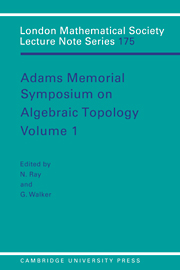Book contents
- Frontmatter
- Contents
- Preface
- Contents of Volume 2
- 1 The work of J. F. Adams
- 2 Twisted tensor products of DGA's and the Adams-Hilton model for the total space of a fibration
- 3 Hochschild homology, cyclic homology and the cobar construction
- 4 Hermitian A∞ rings and their K-theory
- 5 A splitting result for the second homology group of the general linear group
- 6 Low dimensional spinor representations, Adams maps and geometric dimension
- 7 The characteristic classes for the exceptional Lie groups
- 8 How can you tell two spaces apart when they have the same n-type for all n?
- 9 A generalized Grothendieck spectral sequence
- 10 Localization of the homotopy set of the axes of pairings
- 11 Fibrewise reduced product spaces
- 12 Computing homotopy types using crossed n-cubes of groups
- 13 On orthogonal pairs in categories and localization
- 14 A note on extensions of nilpotent groups
- 15 On the Swan subgroup of metacyclic groups
- 16 Fields of spaces
- 17 Maps between p-completed classifying spaces, III
- 18 Retracts of classifying spaces
- 19 On the dimension theory of dominant summands
8 - How can you tell two spaces apart when they have the same n-type for all n?
Published online by Cambridge University Press: 29 January 2010
- Frontmatter
- Contents
- Preface
- Contents of Volume 2
- 1 The work of J. F. Adams
- 2 Twisted tensor products of DGA's and the Adams-Hilton model for the total space of a fibration
- 3 Hochschild homology, cyclic homology and the cobar construction
- 4 Hermitian A∞ rings and their K-theory
- 5 A splitting result for the second homology group of the general linear group
- 6 Low dimensional spinor representations, Adams maps and geometric dimension
- 7 The characteristic classes for the exceptional Lie groups
- 8 How can you tell two spaces apart when they have the same n-type for all n?
- 9 A generalized Grothendieck spectral sequence
- 10 Localization of the homotopy set of the axes of pairings
- 11 Fibrewise reduced product spaces
- 12 Computing homotopy types using crossed n-cubes of groups
- 13 On orthogonal pairs in categories and localization
- 14 A note on extensions of nilpotent groups
- 15 On the Swan subgroup of metacyclic groups
- 16 Fields of spaces
- 17 Maps between p-completed classifying spaces, III
- 18 Retracts of classifying spaces
- 19 On the dimension theory of dominant summands
Summary
In 1957, Adams gave the first example of two different homotopy types, say X and Y, whose Postnikov approximations, X(n) and Y(n), are homotopy equivalent for each n. He did this in response to a question posed by J.H.C.Whitehead. Adams gave an explicit description of both spaces and showed they are different, up to homotopy, by noting that one contains a sphere as a retract whereas the other does not, [1]. Recently, in our study of infinite dimensional spaces, we have had to confront the same problem. Often we can prove that for a given space, e.g., X = S3 × K(Z, 3), there are many other spaces, up to homotopy, with the same n-type as X for all n. But when asked to describe one of them, we had to plead ignorance. To correct this situation we began to look for explicit descriptions and for homotopy invariants that are not determined by finite approximations. In doing so, we found some new examples and a new answer, involving automorphism groups, to the question posed in the title. This paper deals with those examples. We find them intriguing, in part, because they indicate an unexpected lack of homogeneity among spaces of the same n-type for all n. Nevertheless, as examples go, Adams's original one remains one of our favorites because of its simplicity and explicit nature. We commend it to the reader.
Information
- Type
- Chapter
- Information
- Adams Memorial Symposium on Algebraic Topology , pp. 131 - 144Publisher: Cambridge University PressPrint publication year: 1992
Accessibility standard: Unknown
Why this information is here
This section outlines the accessibility features of this content - including support for screen readers, full keyboard navigation and high-contrast display options. This may not be relevant for you.Accessibility Information
- 2
- Cited by
